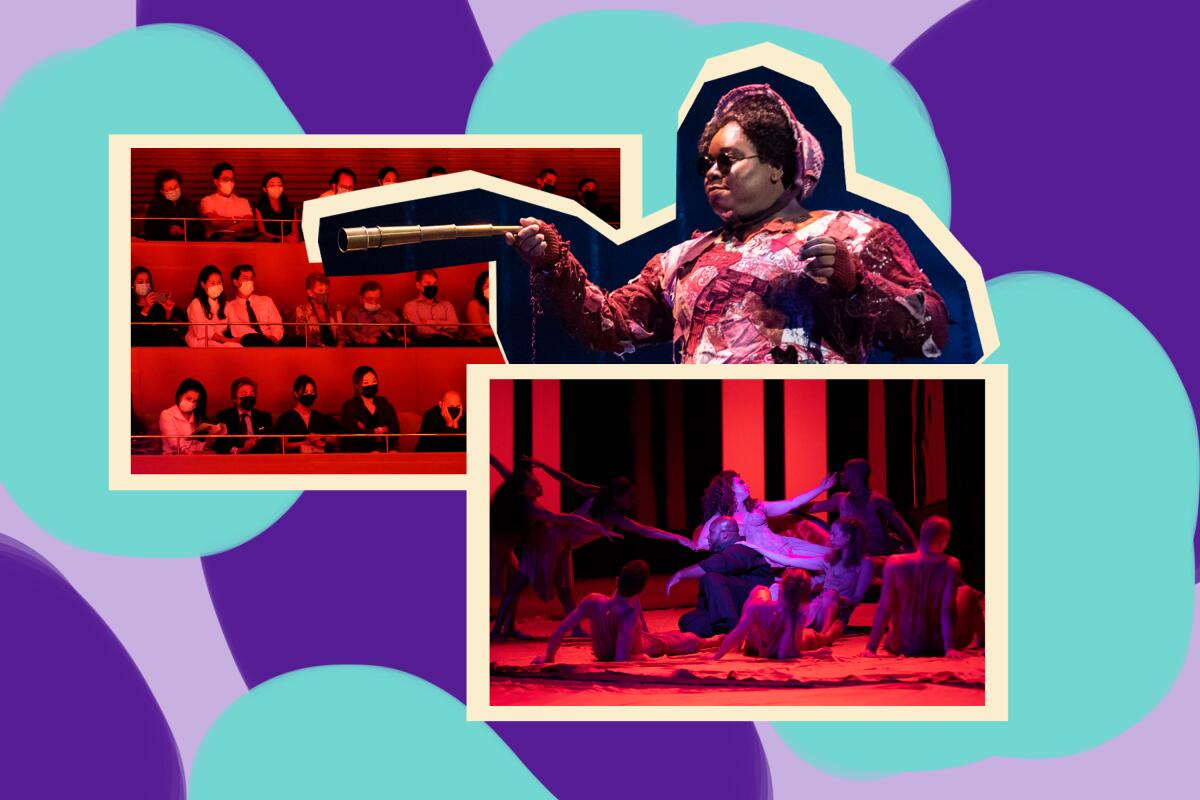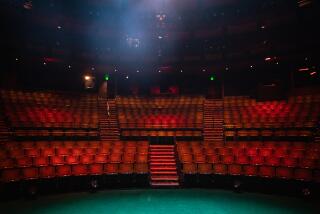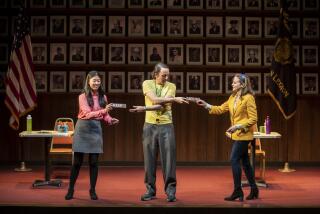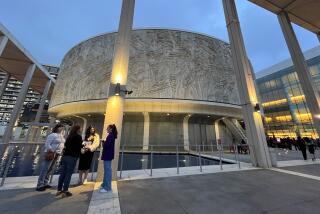Commentary: Sitting in the audience in 2021 required a dramatic trust fall

- Share via
There is perhaps nothing more communal than the air we breathe. Now that the oxygen entering our lungs can carry an invisible infection capable of sickening and even killing us, we have lost the very foundation of trust that public space is built upon.
The danger is greater inside, so passing through a doorway into a room filled with strangers requires that we weigh the risks versus the rewards. This is particularly true in the places where we linger longest in close proximity to others: theaters and live music venues.
Performing arts organizations have taken a cruel pummeling during the past 22 months, with most venues remaining shuttered for more than a year. Many hoped vaccines would put a deus ex machina-style end to the virus. Instead, inoculations provided an early summertime reprieve before the stage-left entrance of the villainous Delta variant resulted in another wave of uncertainty and fear.
Delta tempered reopening plans but it did not stop them. The digital performances that big and small houses had polished over the summer could be extended just a bit longer. By fall many of us had come to terms with the fact that the virus was becoming endemic and that we would have to find a way to live alongside it. Hiding ourselves away was no longer a reasonable option. Armed with newly abundant N95 masks and brandishing wrinkled vaccine cards, we headed back to our seats in the audience.
For a month or so, the view from our new-world perch looked fine — not ideal but tolerable. Then the music changed — chords crashed discordantly and Omicron slipped onstage, twirling its mustache from behind its collared cape. This new variant conjured images of malevolent presences in a Marvel movie, and we were asked to rethink all of our carefully laid plans.
This new threat changes almost every pandemic line we’ve learned over the past two years. Two vaccine doses are no longer enough, we are told — three are needed for adequate protection to kick in. The Metropolitan Opera in New York City is now requiring all eligible employees and audience members to show proof of a booster to enter the house by Jan. 17. In the meantime, Omicron is spreading at an alarming rate. Unprecedented waves of cancellations are hitting Broadway, and in L.A. Center Theatre Group first canceled three performances of “A Christmas Carol” due to infections within the company and then cut short the run, which had been scheduled to continue through Jan. 1.
What is a pandemic-weary theater fan to do?
As 2021 comes to an unsatisfying close — like a meandering play with no clear sense of moral purpose — we are forced to examine our relationship with a world we no longer recognize. The effects of the pandemic aren’t likely to dissipate anytime soon. The virus will not mutate to meet our needs, so we must adapt to accommodate its demands on our way of life. When it comes to the performing arts, our full-scale return to the audience requires the pandemic equivalent of a trust fall.
If your partner chooses not to catch you in an acting class trust-fall exercise, you can end up with a bruised tailbone. A pandemic trust fall gone awry can result in hospitalization or worse, which is why many of us chafe at mask malefactors — those who use the protective gear as a chin bra or nostril necklace. After learning to eschew hugs and handshakes, we must relearn how to be with one another in the public realm. We must have faith that belonging to the same theatergoing community means that we have each other’s best interests at heart.
I went to my first live performance of the pandemic in early November. Even though everyone was required to show proof of vaccination and wear a mask, I still felt vulnerable. At one point during the show I had to ward off a rising panic as I gazed around me at all the humans, breathing. I had to squash an urge to run for the nearest exit. A mask-muffled cough made me flinch. I could not wait to step outside.
Such feelings are incongruous with the enjoyment one seeks when one sits down in a theater. But I plan to keep doing it. The more I practice, the better it will feel — until the previously unimaginable situation begins to seem almost normal. I had to do the same thing with grocery stores after I was vaccinated. The first time I went back to the aisles I wore a double mask, a face shield and gloves. When each subsequent visit proved safe, I shed a layer of my overly cautious attire until a simple KN95 mask felt just right, and the thought of a trip to a crowded place no longer made my stomach twist with anxiety.
For those of us at The Times who attend live performances for a living, calculating the risk inherent in indoor public settings has become a professional necessity. We have to trust that most people no longer venture out while sick, that they are not manufacturing fake proof of vaccination, that they are careful and considerate with their health in the course of their daily lives. In these polarized times, that’s a whole lotta trust.
While writing this story, I reached out to my colleagues, Times theater critic Charles McNulty and classical music critic Mark Swed, for their thoughts on what it currently feels like to be an audience member.
“Returning to indoor performance has been fraught,” McNulty wrote in an email. “Before making my first foray into a packed house, I plotted how I might beat the line for the restroom at intermission. What I didn’t prepare for was the new occupational hazard of fogged up glasses. I’m still making discoveries, such as how to deal with an itchy nose and, just the other night, an incipient asthma attack while wearing a mask. But I think theater audiences have become more cooperative over time.”
He continued with these sage words, “If you’re looking to be annoyed by the public, you’ll never lack for excuses. I urge myself to worry only about what I can control. I got my booster, I avoid hugs and handshakes and I wear a good quality mask. I literally breathe a sigh of relief when I’m back in my car. But for me attending theater under these conditions is preferable to staying home and scrolling futilely through Netflix.”
Swed mused about how masks — whether seen during a livestream from Milan of La Scala’s opening night or in the Los Angeles halls of the Dorothy Chandler Pavilion — are often worn incorrectly.
He noted that rules about vaccination, including exemptions and the timeframe during which one can take a negative COVID test, vary from venue to venue. In his experience, deciding whom to sit next to during a show can be challenging because next thing you know that person might pull down their mask.
“Say something or not? Stay or leave? Ushers may or may not be helpful. The lady in front of me at L.A. Opera’s four-hour ‘Tannhäuser’ was well masked and only took it off to cough (which was frequently),” Swed wrote in an email.
“All in all,” he concluded, “theater in L.A. is surely safer than dining indoors. It’s got to be a better bet than many a holiday party. So many careless attendees at a Fox Studios screening put me off even thinking of going into an actual movie theater. The odds of dying from COVID-19 caught at the Music Center are likely lower than being killed driving on the 10 towards the beach after a Saturday night performance. But both require caution, and you can’t always be in control.”
Trust, after all, isn’t a matter of control. It’s a matter of acceptance.
Masks and vaccine-card checkpoints need not channel the ugliness of the political rhetoric they engender. When viewed as tools of kindness and civic duty, they can take on an uneasy beauty — like a daisy growing through a crack in the pavement.
More to Read
Updates
4:00 p.m. Dec. 21, 2021: This story was updated with news of the early end to “A Christmas Carol” at the Ahmanson Theater.
The biggest entertainment stories
Get our big stories about Hollywood, film, television, music, arts, culture and more right in your inbox as soon as they publish.
You may occasionally receive promotional content from the Los Angeles Times.











